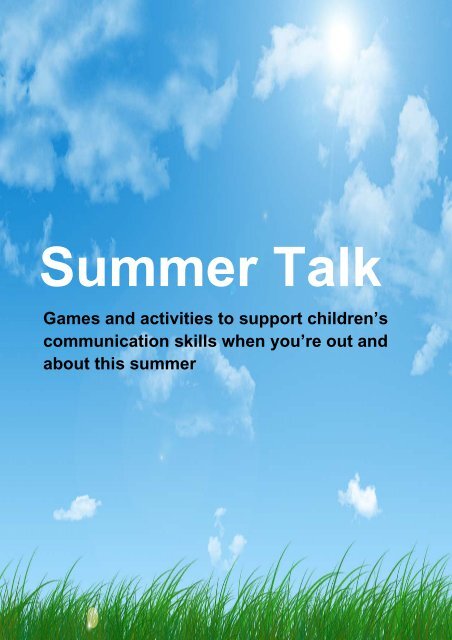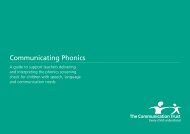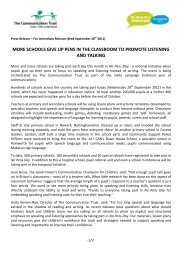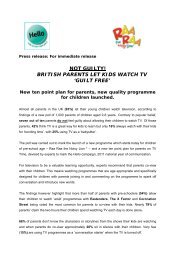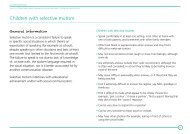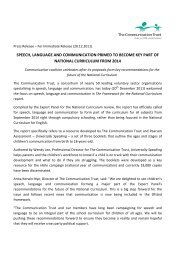Summer Talk - The Communication Trust
Summer Talk - The Communication Trust
Summer Talk - The Communication Trust
- No tags were found...
You also want an ePaper? Increase the reach of your titles
YUMPU automatically turns print PDFs into web optimized ePapers that Google loves.
<strong>Summer</strong> <strong>Talk</strong>Games and activities to support children’scommunication skills when you’re out andabout this summer
<strong>Summer</strong> talkThis August, you and your family may be spending lots of time together going out and aboutlocally. You may even be planning exciting day trips or even going away on holiday.Here at the <strong>Communication</strong> <strong>Trust</strong>, we know how important family time is. In this <strong>Summer</strong> <strong>Talk</strong>toolkit, you’ll find a range of games and activities that are fun and easy to do whilst at the sametime encouraging your children’s communication skills.We‘d like to thank our partners from across the country who have contributed their brilliant ideasand activities to this toolkit as part of their support of Hello (national year of communication).Visit www.thecommunicationtrust.org.uk for further information, free resources and to sign up forregular updates.What’s inside this pack?• Museum fun – question ideas to start a conversation with your children.• Zoo fun! – help your children learn the signs for different animals at the zoo and goexploring together.• Trolley challenge – keep your kids amused in the supermarket and develop their languageskills at the same time.• Car challenge – exhausted by the thought of long journeys? Check out our ideas andchallenges for journeys.• Picnic fun! – take the family out for a teddy bears picnic and use songs and rhymes todevelop communication skills.• Sports challenge – take the classic game of ‘throw and catch’ to the next level.• Kitchen fun – make a noisy lunch at home and get help from your children in the kitchen.• Top tips for communication with your child – top tips to support children’s speech,language and communication.• And there’s more... – useful websites with more games and activities that you can do withyour children at home or out and about.
Why communication?It’s easy to think that children’s speech, language and communication develops no matter what.But this isn’t true.Speech, language and communication underpins everything we do, yet children don’t learn to talkby accident.Adults play a really important role in nurturing and supporting these skills. Listening to whatchildren say, giving them ideas and creating opportunities for talk and interaction can make a bigdifference to children’s ability to live life to the full.
Museum tripMuseums are a great place to visit. You can be guaranteed there’ll be things you’ll see that youdon’t normally come across in your daily life, and for that reason it offers a lot to talk about.Wherever you live you’re likely to have a local museum nearby. Check out your local councilwebsite for details of your nearest.Many museums offer activities for children that are free or low cost. Why not combine a trip to themuseum with a picnic in a local park? It’s a perfect cheap day out.Activities to tryMuseum treasure huntMake a fun game searching out the following items and talkabout what you find;- What’s the oldest thing you can find?- Can you find something from faraway?- What’s the smallest exhibit you can find?- What’s the biggest exhibit you can find?- What’s the funniest looking item you can find?Become an inventor for the day!Great questions to ask any budding inventor- Imagine you’re an inventor for the day - what would you invent?- Tell me more about what your invention would look like?- Tell me more about what it would do?- How big is it?- What is it made of?- How does it work?- Can you draw a picture of your invention?This fantastic activity comes from Fink (Family Interaction Nurtures Kids). Fink is passionate about communication andthey’re on a mission to get people talking. For more information log onto www.finkcards.comFink has partnered with Hello for this month’s ‘talk and go’ theme. During August they’re offering 50% off any orderwhen you quote HELLO online. You can also find free tips, advice, resources and expert blogs on helping your childbecome a confident communicator at www.finkcards.co.uk/resources/blog
Zoo funA family trip to the zoo offers many things to talk, or sign about, and there’s lots of fun to be had.Can you spot these as you walk around?MonkeyLionWorking clawed handscratches under workingarm.Clawed hands (palms in, pointing up) outline mane andthen make alternate clawing movements (palms forward,pointing up).Snake Spider GiraffeWorking bunched hand(palm down, pointingforward) “snakes”forwards. Directional sign.Working clawed hand(palm down, pointingforward) by side of head,moves down with fingerswriggling.Pads of thumb, middle andthird fingers of workinghand touching, index andlittle fingers extended(palm in, pointingup);supporting cuppedhand (palm back, pointingin) moves up and downworking forearm.<strong>The</strong>se sign diagrams and text descriptions come from Signalong. To access more information, additional resourcesand further free, summer, downloadable signs go to www.signalong.org.uk/news/index.htm
Trolley ChallengeKeep your children amused and develop their communication skills, as you go around thesupermarket with the Trolley Challenge. You have a lot to think about as you shop, so here aresome quick and easy things to do with your child at the same time, whatever their age. If you havechildren of different ages, swap the activities you do, so they all have a turn.0 – 6 monthsEvery time you put something in your trolley – look at your baby. How many different faces doeshe/she make?6 – 12 monthsEvery time you put something in your trolley – talk or make noises with your baby. How manynoises does your baby make in return?12 – 18 monthsEvery time you put something in your trolley – show it to your baby and tell them what it is18 – 24 monthsEvery time you put something in your trolley – say the name of the object and add the word ‘in’,e.g. ‘banana in’24 – 36 monthsEvery time you put something in your trolley – say the name of the object and add a describingword, e.g. ‘big banana’3 – 4 yearsEvery time you put something in your trolley – clap out the syllables in the word, e.g. ba/na/na = 3claps4 – 5 yearsEvery time you put something in your trolley – ask your child to tell you 2 things about it, e.g.banana – ‘it’s yellow and you eat it’This Trolley Challenge activity comes from Cambridgeshire Community Services NHS <strong>Trust</strong>. You can find out moreabout their work at www.slc.cambridgeshire.gov.uk. This site includes excellent activities and information to supportparents and carers.
Car challengeExhausted at the thought of keeping your kids amused on a long journey? Try these activities toensure travel time is fun and educational rather than a stressful experience for everyone involved!Present timeWrap up little presents for children to open at certain times on long journeys. <strong>The</strong>se can be cheapand simple things such as a box of raisins, pipe cleaners to play with, crayons or travel game likeGuess Who. <strong>The</strong> excitement is in guessing what’s inside! Get children to describe the shape of theparcel; whether it’s soft or hard, what they think might be inside and why.Guess the characterYou describe a character from a TV programme, a film or book and the children have to guesswho you’re talking about. <strong>The</strong>n they describe someone and you guess.I SpyThis can be with things you can actually see or even things that you’re thinking of. For youngchildren, describe the object as well as giving the first letter of what you’re thinking about.Registration plate challengeMake up silly phrases based on the registration plates of vehicles you pass: C989 VAE = VeryAmazing ElephantsLet’s pretendPretend your car’s a different vehicle (such as a submarine)and make up a story about it. ‘<strong>The</strong> submarine is beingchased by three pink hammerhead sharks.’ Take turns toadd the next sentence or part of the story so that everyonein the car adds something.Passenger mathsGive a number to people and animals in cars that you pass e.g.:1 for a man2 for a woman3 for a child4 for a petTake turns and keep your score. <strong>The</strong> first to get to an agreed number of points, e.g. 50 or more,wins the game.Car footballEveryone in the car chooses an unusual type of vehicle (like a tractor), or a less common colour ofvehicle (yellow), or a specific type of lorry (like a Sainsbury’s lorry). Whoever sees their chosenvehicle coming towards them scores a goal, but if the car overtakes a chosen vehicle everyoneelse scores a goal. Once someone has seen or overtaken their chosen vehicle, they have to picka different one.
Picnic funWhy not go to the park on a sunny day for a Teddy Bear’s Picnic and use songs and rhymes tohelp develop your children’s communication skills. Here are a few for you to tryTo the tune of ‘Drunken sailor’What do we need when we go on a picnic?What do we need when we go on a picnic?What do we need when we go on a picnic,on a sunny morning?Lots of apples and chocolate biscuitsLots of apples and chocolate biscuitsLots of apples and chocolate biscuitson a sunny morningChildren can suggest ideas and you can mimeactions eating the different foodsSpoken rhymesChop chop choppety chopChop off the bottom and chop off the topWhat you have left – you can eat the lot!Chop chop choppety chopYou can accompany this with drums, rhythmsticks etc (beating in time with pulse of therhyme in a chopping action)Slice slice the bread looks niceSpread spread butter on the breadOn the top we’ll put some ham/cheese/jam etcMake it tasty for your Ted(as in a teddy bear’s picnic)Accompany with a spreading action
To the tune of ‘Frere Jacques’Lick your ice creamLick your ice creamWith your tongueWith your tongueIt’s all sweet and stickyIt’s all sweet and stickyYum, yum, yum! Yum, yum, yum!To the tune of ‘<strong>The</strong> sun has got his hat on’<strong>The</strong> sun has got his hat on, hip hip hip hooray<strong>The</strong> sun has got his hat on and he’s coming out to playWe have got our hats on, hip hip hip hoorayWe have got our hats on and we’re coming out to playWe have got our sun cream on, hip hip hip hoorayWe have got our cream on and we’re coming out to playTo the tune of ‘Here we go round the mulberry bush’Here we go round the picnic rug,the picnic rug, the picnic rug.Here we go round the picnic rug,on a sunny morning.This is the way we...peel an orange/ bite an apple/ drink our juice etcon a sunny morning.Children hold hands and walk in a circle round thepicnic rug, then do appropriate actions for eachverseWe’re going on a picnic, leaving right awayIf it doesn’t rain we’ll stay all dayHave you got the sandwiches?Yes I’ve got the sandwichesHave you got the bananas?Yes I’ve got the bananas etcGoing on a picnic on a sunny day.Children provide the answers to the‘Have you got the...?’ questions.This fantastic activity is part of a <strong>Communication</strong> Picnic Pack developed by Norfolk Community Health and CareNHS <strong>Trust</strong> and Children’s Speech and Language <strong>The</strong>rapy team. Inspired to download the <strong>Communication</strong> PicnicPack? Log onto www.hello.org.uk/talkandgo
Sports challengeEven a simple game of ‘catch and throw’ can be turned into an opportunity for fun andcommunication. Over the Line is a throwing and catching game that’s a doddle to set up and adelight to play.What you’ll need:A ball you can throw, like a tennis ball and some cones.You can play Over the Line with different numbers of players but 3 a side areideal.• Start by marking out 2 lines say 10 metres long and 10 metres apart (see the diagrambelow).You can alter the distances once you’ve seen how well your children can throw.• <strong>The</strong> space between the lines is out of play.• Get the 2 teams to stand behind their lines. <strong>The</strong> red teamstarts and a player throws the ball from a few paces behindtheir line. <strong>The</strong> aim is to throw the ball so it lands in theopponent’s area anywhere behind the line.• Once it’s crossed the line the whites try to catch the ball or atleast touch it before it lands.• If the ball hits the ground without being caught or touched, thethrowing team gets a point.• If someone in the receiving team catches the ball, they get a point. If they touch the ballbut don’t catch it, then nobody gets a point.• <strong>The</strong> player who catches or touches the ball, must throw it back from where they werestanding.• If the ball hits the ground to score a point, the nearest player to where it landed takes thenext turn from that spot.As well as helping children build their throwing and catching skills, the game also teaches themsomething about tactics. That’s because how you position your players is an important part ofplaying the game well.BT sponsored the Hello campaign. Over the Line is one of 12 Coaching for Life resources, developed as part of BT’sofficial London Olympics 2012 education programme. Parents and carers are encouraged to get their children (6-11year olds) to try different sports and to give them opportunities for communication.Find out more at www.bt.com/coachingforlife. You’ll find downloadable instructions for all 12 games, along withvideos of how to play. <strong>The</strong>re are also downloadable coaching tips, a coaching tips video and information on theiTunes Coaching for Life app.
Kitchen funIf you find yourself at home this summer, why not get the family together in the kitchen? Making anoisy lunch together is an excellent opportunity for talking and having fun.Have fun in the kitchen with your childrenMake a noisy lunch together, talking and copying thesounds you hear. Encourage children to learn vocabularyby introducing new equipment and unusual foods.Here are some ideas:Listen to the sounds- Listen to the sounds in the kitchen.- <strong>Talk</strong> about and copy the sounds of different kitchen utensils and equipment:Metal spoonsFood processorKnives choppingListen to the soundsTake turns to talk about the different sounds you make as you eat.Chewing slurping, munching and crunching!Guess the noise:1. Pick a noisy utensil or piece of equipment in the kitchen2. Tell your child to close their eyes and listen carefully3. Make a noise e.g. chop on a board4. Get your child to open their eyes and make a guess5. If they’re wrong, do it again and then show themThis Noisy Kitchen activity was adapted from a 0-5s activity resource written by Humber NHS Foundation <strong>Trust</strong>, inconjunction with Hull City Council, East Riding of Yorkshire Council and East Riding of Yorkshire Families InformationHub Service (FISH). You can also find other kitchen activities from our Hello partners at www.hello.org.uk/talkandgo
Top tips for communicating withyour childBelow are some top tips for communication development when you are out and about thissummer.• <strong>Talk</strong> about the things your child is interested in. For example, if they’re playing on the slide inthe park, go over and comment ‘weeee you’re sliding down’• Use comments and prompts to keep the conversation up. <strong>The</strong>y’re better than questions forkeeping children involved. For example, if your child is eating an ice-cream, comment, ‘Mmm,that looks good. I love ice-cream.’ <strong>The</strong>y can then respond with more words than if you ask‘What’s that you’re eating?’• Put aside time each day for talking together• If your child doesn’t get it quite right the first time, don’t say “that’s wrong”, say it back the rightway. For example, if your child says, “I goed swimming”, just say back to them, “yes you did,you went swimming.’• Explore words - talk about new words when your child comes across one• Enjoy conversations with your child - children learn from conversations with adults as much astheir friends• Comment on your child’s play using simple language, such as “horse jumping”, “man eatingorange”• Ask your child to follow simple instructions, for example feed a teddy,and see if they can copy• Remember to OWL! 1) Observe your child 2) Wait for them to interactwith you 3) Listen to their responses to you• Extend what your child is saying by one more word than they can say. Ifthey say “soup please” you say “tomato soup please”. Or if they say“want soup please” you say “Hannah wants soup please”• If you’re doing any activity, it can be a good idea to do the same thingbeforehand so that children know what to expect. For example makingsandwiches for a picnic. You could also recap the activity after you’vedone it. This helps to develop children’s ability to understand and say the words involved in theactivity, because you’ll be repeating them.• Most importantly - have fun!If you’re concerned about your child’s communication, log onto <strong>Talk</strong>ing Point(www.talkingpoint.org.uk) and use the ‘progress checker’. You can also find your nearestspeech and language therapy services using the postcode searchable database.<strong>The</strong>se tips have been provided by both Oxford Health NHS Foundation <strong>Trust</strong> and Oxfordshire County Council, andNorfolk Community Health and Care NHS <strong>Trust</strong>. <strong>The</strong>y have been adapted from their summer resources Make themost of your summer and <strong>Communication</strong> Picnic Pack. To find out more on these, go to www.hello.org.uk/talkandgo
Useful websitesTo keep up to date with <strong>The</strong> <strong>Communication</strong> <strong>Trust</strong>, visit and bookmarkwww.thecommunicationtrust.org.ukIf you want more ideas for how to keep your children entertained, have a look at the following:Finkwww.finkcards.co.ukHelps families improve communication with cards and games that get families talking.<strong>Talk</strong> to your Babywww.talktoyourbaby.org.uk/home and www.talktoyourbaby.org.uk/partypack4Ideas on having a party, tips for communicating with your children, fun stuff to do such as stories towatch, rhymes to sing and also downloadable activity sheets e.g. sheets for colouring.Family Timewww.familytime.co.ukA whole range of ideas for activities both indoors and outside, with examples of activities todownload, recipes for baking, competitions and more.National Deaf Children’s Societywww.familysignlanguage.org.ukFun and friendly website for families of deaf children to learn British Sign Language (BSL) and togive practical advice on how to use BSL at home this summer.www.buzz.org.ukInformation for deaf children and young people to let them know what is going on in their area overthe summer. It has two sections, one for ages 8-11 and another for ages 12-18.Makatonwww.makaton.org/khxc/gbu0-catshow/children-play.htmlIdeas for games and activities to help children to use Makaton, informally and spontaneously.BBCwww.bbc.co.uk/cbbc/thingstodoHas a wide range of creative activities to do at home for rainy days. <strong>The</strong>re are arts and craftsactivities, ideas for dressing up, colouring in and more.Netmumswww.netmums.comParenting advice, information and events in your local area.Mumsnetwww.mumsnet.comNews, special offers, competitions and information in your local area.Change4Lifewww.nhs.uk/Change4Life/Pages/fun-generator.aspxContains lots of activities to do over the summer.


